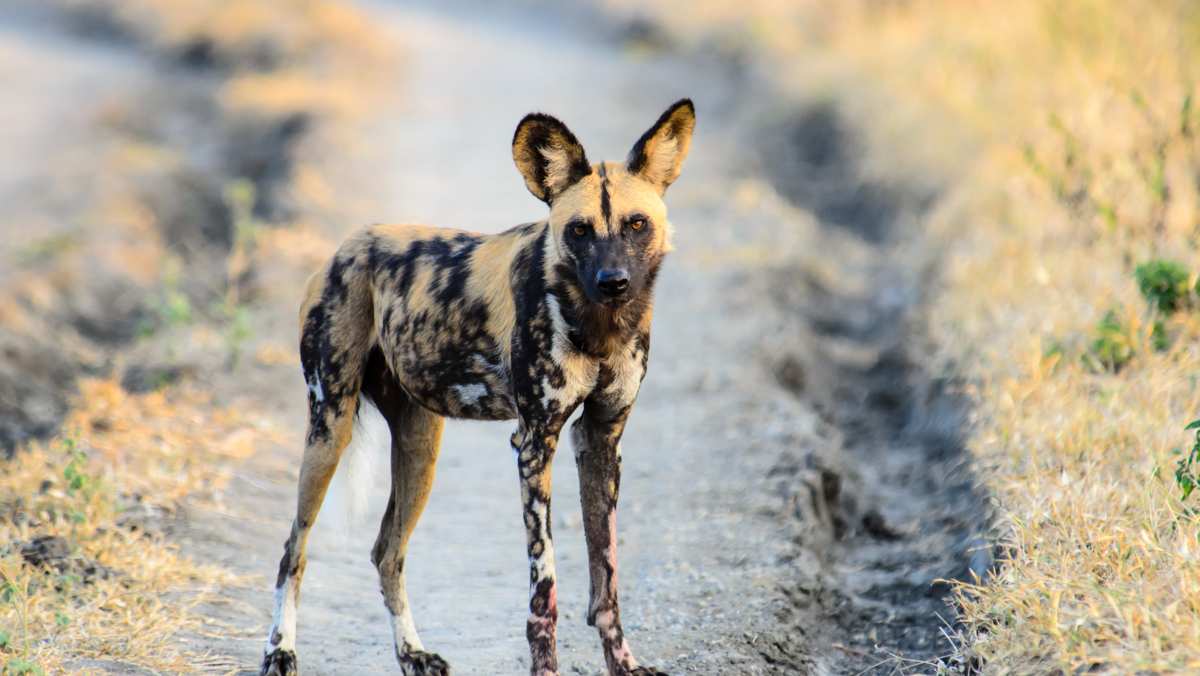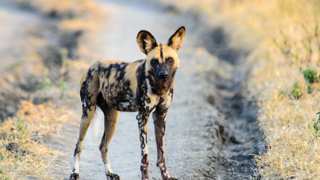African Hunting Dog
African Painted Dog
African Painted Wild Dog
African Wild Hunting Dog
Cape Hunting Dog
Cape Wild Dog
Chad Wild Dog
East African Wild Dog
Lycaon Pictus
Painted Hunting Dog
Painted Wolf
Somali Wild Dog
Spotted African Dog
West African Wild Dog
Wild African Dog
Pronunciation: [Af·ri·ken wī(-ə)ld dog]
The African Wild Dog is a species that is also its own genus; the only other known species in the genus, the Lycaon sekowei, is long dead. This "dog" is believed to be nearly 3 million years old, was significant in the prehistory of Egypt and is the ancestor of today's domesticated dog even as it is not itself a dog. Attempts to domesticate this incredibly intelligent, remarkably social and otherwise thoroughly untamable animal are said to be the very reason it is about to disappear once and for all from the face of the Earth.
African Wild Dog Breed Details
The African Wild Dog is not a dog, and as such it cannot be classified within a Dog Group. The American Kennel Club (AKC) has acknowledged this animal by way of studies, however, for the species is not under the genus Canis but Lycaon — although both dogs and African Wild Dogs are in the family Canidae. Along with the AKC, there are a great many conservation groups that can provide in-depth African Wild Dog facts.
African Wild Dogs are obligate carnivores, meaning they don't merely eat meat but they must eat meat. As such, their purpose in life, as predators, is to help prevent overpopulation of other species. One needs only to look humans to realize why the African Wild Dog is endangered. These animals are in no way meant to be domesticated, and as a result of human encroachment into the Wild African Dog habitats, their population is dying out.
With respect to domestication, there are no "pros."
They will eat you (yes, and kids)
They will eat your pets
They will outrun any possible prey
They are inherently resistant to attempts by humans to tame them
They are endangered due to diseases that have conflated among them since attempts at domestication
Wild
10 - 12 yrs.
24 - 30 in.
44 - 66 lbs
OverallFamily FriendlyChild FriendlyPet FriendlyStranger Friendly
Easy to GroomEnergy LevelExercise NeedsHealthShedding Amount
Barks / HowlsEasy to TrainGuard DogPlayfulnessWatch Dog
Apartment DogCan be AloneGood for Busy OwnersGood for New OwnersIntelligence
African Wild Dog Breed Description
A number of contradictions hounds the African Wild Dog: it is a remarkably ancient animal but also nearly extinct; it is highly social among its own kind but viciously wild when it comes to humans. There is a lot of African Wild Dog information available, and below some of the most basic info is encapsulated.
This is an animal that relies not on instinct but intelligence. The pups are not born with the "knowledge" of how to hunt, communicate, etc., but are taught these things and, in turn, pass them on to subsequent generations. Because of this, the African Wild Dog is able to assess, evaluate and reassess hunting and killing their prey in a far higher success rate than perhaps any other animal (80% compared to the lion's 30%).
Communication is key to the African Wild Dog's tightly knit social style. Using a wide variety of dynamic sounds, visual cues and touch, the animals communicate quickly, concisely and often discreetly.
This species is known for speed and endurance. While most animals on this planet can either go at great speeds in short bursts or long distances at relatively low speeds, the African Wild Dog can run at fast rates for very long distances.
African Wild Dog Breed History
The African Wild Dog has been around for far longer than domesticated dogs: it is believed to have existed nearly 3 million years ago. It was one of the breeds that long ago mated with another species — perhaps the Dingo or a wolf — to create dogs as we know them today. Although this animal, which goes by the name African Wild Dog, is not a dog, it is also neither a wolf (indicated by its Latin name, Lycaon pictus, i.e., "painted wolf") nor a hyena. (It was originally thought to be a hyena when, in 1820, it was labeled Hyaena picta; this was rectified a few years later in 1827 when it was renamed Lycaon tricolor.)
There is a fair amount of art, mythology and symbology regarding and surrounding the African Wild Dog history. It was depicted in art that has been dated back to the Predynastic period of Egypt, meaning this species was informally recognized more than 5,000 years ago. It as believed that this "dog" represented order as well as a transition from the wild to the civilized.
Despite its ferocity, its collective attempt to remain wild and its broad travel range throughout inhospitable regions, the African Wild Dog is on the brink of extinction. According to the International Union for the Conservation of Nature (IUCN), there are approximately 6,600 of these dogs alive in the wild — and the number dwindles annually.
African Wild Dog Appearance
To the lay eye, the African Wild Dog appearance may look a bit like a hyena or perhaps a fox with freaky ears. This unique mix of a species with its own genus (there are no other living species in the genus Lycaon) is distantly associated with the dog family, Canid. Nevertheless, a closer inspection — which is not recommended to do in person! — will reveal that this dog is in many ways like few other animals.
You may ask, Why do African Wild Dogs have big ears? Those large, round and flat ears which are almost perpetually perked up help to keep the "dogs" cool in the hot desert climates. The spindly legs allow them to be lightning quick: they can reach speeds of 35 mph, even over long distances. They have fewer teeth than the family of dogs with which they are distantly related, and their long, narrow skull — which always sports a thin, black stripe on the face (from the forehead down to the nose) — has developed in every way to serve one purpose: to eat meat. Like their teeth, they also have fewer toes as they never developed a dewclaw.
The coat is multicolored, short and rough while the tail is long and bushy.
The images below represent the coat colors and patterns associated with African Wild Dogs.
Black
Tri-Color
White
Yellow
African Wild Dog Variations
The African Wild Dog species is an intriguing one which long ago mated with another species to help create the many hundreds of domesticated dog species we know and love today. These days, however, the African Wild Dog is its own genus and species, and it cannot breed outside of this genus / species. Moreover, it is not a dog as we know it.
There are basically five subspecies, or types, of African Wild Dogs: the Cape Wild Dog, the Chadian Wild Dog (or Central African Wild Dog), the East African Wild Dog, the Somali Wild Dog and the West African Wild Dog.
The astounding amount of fur colors and patterns would be difficult to discuss here. Suffice it to state that while there are some basic patterns (such as a black muzzle) and there are some common aspects respective to geographic regions (predominantly black coats in the north-east while those in the south have brighter-colored coats). On top of all that, however, is the fact that no two African Wild Dogs look alike; each of these wild dogs has a unique pattern.
The Somali Wild Dog is the smallest of the five variations, the East African variety is a bit larger (but still smaller than the median size), and the Cape Wild Dog is the largest of them all. The other two subspecies, the Chadian and the West African Wild Dogs, are the median size.
African Wild Dog Temperament
The imagined oxymoron that the African Wild Dog behavior is like a family or a football team is only an oxymoron if you insist on thinking that such terms can only apply to humans or animals that are domesticated by us. These wild dogs are highly social within their packs, follow strict social codes, take close care to raise their pups and follow an alpha male who observes rituals when it comes to protection, hunting and traveling. These are by no means a domesticated species, but they tend to be far more structured, civil and playful among themselves than most people. This is most obvious in the heat of the kill when they remain non-aggressive toward each other even as they may be literally eating alive a still-struggling animal.
Communication among the dogs is key to the a pack's survival, and among the African Wild Dog characteristics are the use of elaborate tactile and aural methods to communicate.
African Wild Dogs live in packs of six to 20, but if the number drops below six, the remaining dogs tend to experience a problem with hunting.
While all of this is intriguing, these are not dogs meant to live in captivity, and you certainly won't be adopting one — let alone a pack — any time soon, as they are not just illegal to own but impractical to domesticate as well. To do so will mean you will be the next meal.
African Wild Dogs as pets are not at all recommended. There is nearly no chance you will live with one — and as they move in packs, one is probably not an option if you went out on that unwieldy branch. They are endangered, dangerous and illegal to export from their native habitat (except, perhaps, for zoos and certain specialists). They are entirely distrustful of humans, and if you chose to live with them in their native habitat, you will face a great many obstacles attempting to do so. Although African Wild Dogs are a distant ancestral cousin to the domesticated dogs we know today, they are simply not to be trifled with.
There are believed to be fewer than 7,000 African Wild Dogs remaining worldwide and the encroachment of humans has done a great deal to fatally affecting the general health of African Wild Dogs (basically through rabies). The attempt to domesticate these "dogs" by ill-informed humans has contributed a bit too. The probiotics found in the regurgitated meat given to African Wild Dogs by their pack members helps to build strong bones and bodies. When these pups are fed by humans, that essential element is absent.
Canine Distemper Virus (CDV) has played no small part too, for as the female tends to roam among packs — leaving one pack shortly after she has birthed a litter so as to repeat the process with another pack — the transmission of the virus can be far, wide and quick. Once one of the dogs is infected, the remarkably close social activity practically guarantees a fever-pitch spread to all the other animals in the pack.
As for the typical African Wild Dog's average life span, it tends to be about 10 years.
African Wild Dog Health Concerns
Below are potential health concerns associated with African Wild Dogs.

